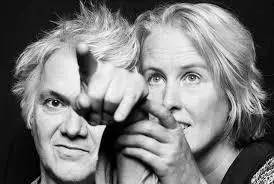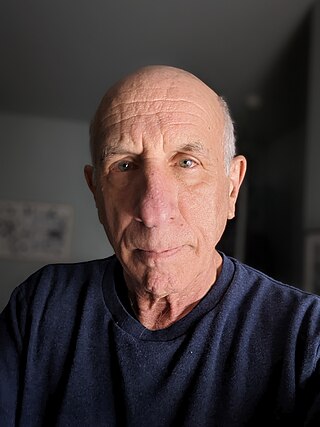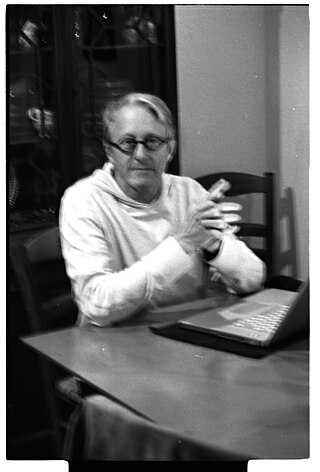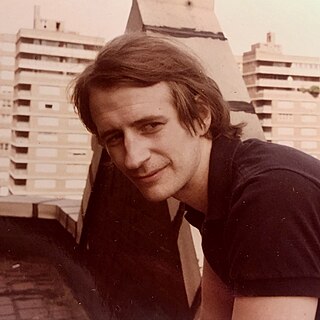Video art is an art form which relies on using video technology as a visual and audio medium. Video art emerged during the late 1960s as new consumer video technology such as video tape recorders became available outside corporate broadcasting. Video art can take many forms: recordings that are broadcast; installations viewed in galleries or museums; works streamed online, distributed as video tapes, or DVDs; and performances which may incorporate one or more television sets, video monitors, and projections, displaying live or recorded images and sounds.

Jodi, is a collective of two internet artists, Joan Heemskerk and Dirk Paesmans, created in 1994. They were some of the first artists to create Web art and later started to create software art and artistic computer game modification. Their most well-known art piece is their website wwwwwwwww.jodi.org, which is a landscape of intricate designs made in basic HTML. JODI is represented by Upstream Gallery, Amsterdam.

The Kitchen is a non-profit, multi-disciplinary avant-garde performance and experimental art institution located at 512 West 19th Street, between Tenth and Eleventh Avenues in the Chelsea neighborhood of Manhattan, New York City. As the organization undergoes a multi-year renovation it is currently sited at a satellite loft space in the West Village located at 163B Bank Street, where exhibitions and performances are regularly held. It was founded in Greenwich Village in 1971 by Steina and Woody Vasulka, who were frustrated at the lack of an outlet for video art. The space takes its name from the original location, the kitchen of the Mercer Arts Center which was the only available place for the artists to screen their video pieces. Although first intended as a location for the exhibition of video art, The Kitchen soon expanded its mission to include other forms of art and performance. In 1974, The Kitchen relocated to a building at the corner of Wooster and Broome Streets in SoHo, and incorporated as a not-for-profit arts organization. In 1987 it moved to its current location.

Cory Arcangel is an American post-conceptual artist who makes work in many different media, including drawing, music, video, performance art, and video game modifications, for which he is best known.

Kenneth Feingold is a contemporary American artist based in New York City. He has been exhibiting his work in video, drawing, film, sculpture, photography, and installations since 1974. He has received a Guggenheim Fellowship (2004) and a Rockefeller Foundation Media Arts Fellowship (2003) and has taught at Princeton University and Cooper Union for the Advancement of Art and Science, among others. His works have been shown at the Museum of Modern Art, NY; Centre Georges Pompidou, Paris; Tate Liverpool, the Whitney Museum of American Art, New York, among others.

Mary Lucier is an American visual artist and pioneer in video art. Concentrating primarily on video and installation since 1973, she has produced numerous multiple- and single-channel pieces that have had a significant impact on the medium.

Steina Vasulka and Woody Vasulka are early pioneers of video art, and have been producing work since the early 1960s. The couple met in the early 1960s and moved to New York City in 1965, where they began showing video art at the Whitney Museum and founded The Kitchen in 1971. Steina and Woody both became Guggenheim fellows: Steina in 1976, and Woody in 1979.
Peter d'Agostino is an artist and a professor of Film and Media Arts, Temple University, Philadelphia.

Chip Lord is an American media artist and Professor Emeritus, UC Santa Cruz and residing in San Francisco. He is best known for his work with the alternative architecture and media collective known as Ant Farm, which he co-founded with Doug Michels in 1968. His work generally takes a satirical look at American myths and legends, they are often "nostalgic, but edged with an ironic detachment."
Skip Blumberg is an American filmmaker. He is one of the original camcorder-for-broadcast TV producers, and among the first wave of video artists in the 1970s. His early work reflects the era's emphasis on guerrilla tactics and medium-specific graphics, but his more recent work takes on more global issues. His work has screened widely on television and at museums. His video Pick Up Your Feet: The Double Dutch Show (1981) is considered a classic documentary video and was included in the Museum of Television and Radio's exhibition TV Critics' All-time Favorite Shows. His cultural documentaries and performance videos have been broadcast on PBS, National Geographic TV, Showtime, Bravo, Nickelodeon, among others.
Electronic Arts Intermix (EAI) is a nonprofit arts organization that is a resource for video and media art. An advocate of media art and artists since 1971, EAI's core program is the distribution and preservation of a collection of over 3,500 new and historical video works by artists. EAI has supported the creation, exhibition, distribution and preservation of video art, and more recently, digital art projects.

Vertical Roll is a 1972 video art piece by American video and performance artist Joan Jonas. It is a sequel to Jonas' first video work Organic Honey's Visual Telepathy. Jonas' interfacing with the material grammar of video was significant to the late 1960s and early 1970s experimentation with new video technology. Among others, Steina and Woody Vasulka, Nam June Paik and Peter Campus also contributed to the emergent material discourse of video art.

Kristin Lucas is a media artist who works in video, performance, installation and on the Internet. Her work explores the impacts of technology on humanity, blurring the boundary between the technological and corporeal. In her work she frequently casts herself as the protagonist in videos and performances where her interactions with technology lead to isolation, and physical and mental contamination.
Frank Gillette is an American video and installation artist. Interested in the empirical observation of natural phenomena, his early work integrated the viewer's image with prerecorded information. He has been described as a "pioneer in video research [...] with an almost scientific attention for taxonomies and descriptions of ecological systems and environments". His seminal work Wipe Cycle –co-produced with Ira Schneider in 1968– is considered one of the first video installations in art history. Gillette and Schneider exhibited this early "sculptural video installation" in TV as a Creative Medium, the first show in the United States devoted to Video Art. In October 1969, Frank Gillette and Michael Shamberg founded the Raindance Corporation, a "media think-tank [...] that embraced video as an alternative form of cultural communication.

Victor Masayesva Jr. is a Hopi filmmaker, video artist, and photographer. Born on the Hopi Reservation of Arizona and growing up in Hotevilla, Masayesva's artistic career reflects his active participation with the Hopi community and his body of work promoting Hopi culture and worldview. Scholar Martin Padget considers Masayesva "one of the most influential Indigenous filmmakers and photographers of his generation." Masayesva's films and photographs are diverse and complex in nature, often employing diverse visual languages, and an experimental approach towards media. The majority of his films are in the Hopi language and are destined for his community, especially to pass-on traditional teachings to youth. Masayesva has also been personally involved in promoting indigenous media, both in the United States and internationally.
Edin Velez is a Puerto Rican video artist, director and professor. He is best known for his work on the documentary films State of Rest and Motion and Dance of Darkness.
Shridhar Bapat (born 1948) was an Indian video artist and key figure in the New York City's downtown video art scene in the 1970s. Bapat's artworks were screened at the MoMA PS1, Whitney Museum of American Art, The Kitchen, and the Mudd Club. He a was an early organizer of video programs at The Kitchen and the Avant-Garde Festivals of New York. He took over as the Director of The Kitchen, an influential experimental artist center in Manhattan, in 1973.
Shalom Gorewitz is an American visual artist. Gorewitz was among the first generation of artists who used early video technology as an expressive medium. Since the late 1960s, he has created videos that "transform recorded reality through an expressionistic manipulation of images and sound". His artworks often "confront the political conflicts, personal losses, and spiritual rituals of contemporary life". Gorewitz has also made documentary and narrative films.
Rita Myers is an American video installation artist. Her work is held in the collection of the Museum of Modern Art in New York.

Ed Bowes is a filmmaker, writer, and director who pioneered the use of video as cinema. The first person to make a feature-length film in video, he used poets, musicians, artists, video- and filmmakers as performers in films such as Romance (1975) and Better, Stronger (1978–79). As a result of the notice given to his camera work, Bowes began his long career as a cinematographer for filmmakers and video artists including Kathryn Bigelow, Lizzie Borden, Vito Acconci, and Robert Longo, among others. In the 1970s, he was instrumental in creating early exhibitions of video art at MoMA, The Kitchen, and other Downtown New York venues. He taught advanced filmmaking for more than three decades at the School of Visual Arts, where he influenced several generations of contemporary filmmakers. His work is in the collection of The Museum of Modern Art, New York, and Moderna Museet in Stockholm, Sweden. It is also represented in The Kitchen Archive at The Getty Research Institute and the Long Beach Museum of Art Video Archive.











